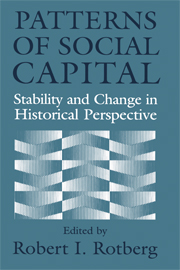Book contents
- Frontmatter
- Contents
- Introduction Social Capital and Political Culture in Africa, America, Australasia, and Europe
- Articles
- Civic Traditions in Premodern Italy
- The Sources of Civil Society in Italy
- Finding Social Capital: The French Revolution in Italy
- Social Capital in the Early Industrial Revolution
- The Diversity of Social Capital in English Communities, 1300–1640 (with a Glance at Modern Nigeria)
- Social and Cultural Capital in Colonial British America: A Case Study
- The Growth of Voluntary Associations in America, 1840–1940
- Civil Society as Democratic Practice: North American Cities during the Nineteenth Century
- Securing Political Returns to Social Capital: Women's Associations in the United States, 1880s–1920s
- Second-Generation Civic America: Education, Citizenship, and the Children of Immigrants
- Human Capital and Social Capital: The Rise of Secondary Schooling in America, 1910–1940
- From Local to National Political Cultures: Social Capital and Civic Organization in the Great Plains
Securing Political Returns to Social Capital: Women's Associations in the United States, 1880s–1920s
Published online by Cambridge University Press: 12 April 2010
- Frontmatter
- Contents
- Introduction Social Capital and Political Culture in Africa, America, Australasia, and Europe
- Articles
- Civic Traditions in Premodern Italy
- The Sources of Civil Society in Italy
- Finding Social Capital: The French Revolution in Italy
- Social Capital in the Early Industrial Revolution
- The Diversity of Social Capital in English Communities, 1300–1640 (with a Glance at Modern Nigeria)
- Social and Cultural Capital in Colonial British America: A Case Study
- The Growth of Voluntary Associations in America, 1840–1940
- Civil Society as Democratic Practice: North American Cities during the Nineteenth Century
- Securing Political Returns to Social Capital: Women's Associations in the United States, 1880s–1920s
- Second-Generation Civic America: Education, Citizenship, and the Children of Immigrants
- Human Capital and Social Capital: The Rise of Secondary Schooling in America, 1910–1940
- From Local to National Political Cultures: Social Capital and Civic Organization in the Great Plains
Summary
Social capital has proven exceptionally fruitful as a metaphor. By invoking financial imagery, this phrase points to the generative power of social ties, their capacity to produce social goods such as economic growth or effective governance. But metaphors are also dangerous, not least because they assert multiple dimensions of similarity, some of which may be inappropriate or positively misleading. Prominent among these potential false parallels is the presumption that social capital is marked by the same portability or fungibility that makes financial capital such a powerful motor of economic growth and transformation. In its purest form, economic capital is not tied to particular persons, places, or objects, but “presents itself as an independent substance, endowed with a motion of its own, passing through a life-process of its own, in which money and commodities are mere forms which it assumes and casts off in turn.” Social capital, by comparison, is fundamentally embedded, rooted in “norms of reciprocity and networks of civic engagement.” The very term “social capital” embodies a seeming paradox—a deeply embedded capacity for social action that is transposable from one setting to another, from one domain to other diverse projects.
In its operation, social capital involves a certain a lchemy, transforming personal ties, trust in specific persons, and localized capacities for collective action into such macro social outcomes as economic performance and political efficacy. This transmutation, however, is fraught with tension.
- Type
- Chapter
- Information
- Patterns of Social CapitalStability and Change in Historical Perspective, pp. 247 - 272Publisher: Cambridge University PressPrint publication year: 2000



